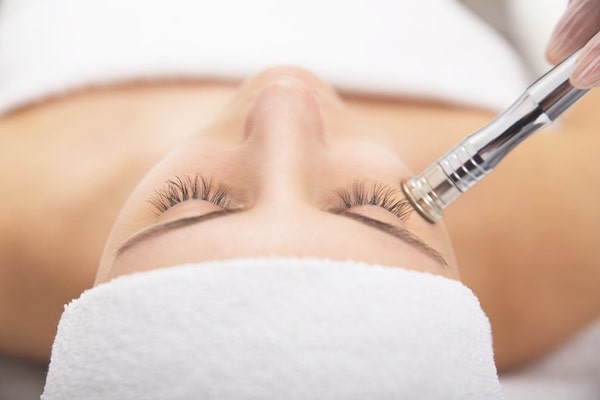Exfoliation is an important step for skin health. Sloughing off dead skin cells can help boost blood circulation, clean pores deeper, even skin tone, help skincare products penetrate more deeply,r and ultimately slow the appearance of aging.
Exfoliating at home is an important step in a skincare routine, but for those who want radical and more immediate visible results, medical skin resurfacing treatments like lasers, deep chemical peels or dermabrasion treatments can help. Learn different ways to resurface your skin and how they help achieve skincare goals.
What Is Skin Resurfacing?
Skin resurfacing treatments can often refer to laser treatments, which use a column of light to create micro-injuries in the skin. This damage signals your body to start its wound healing mechanism, leading to the generation of new cells.
Resurfacing can refer to deeper levels of exfoliation beyond a daily swipe of toner. Chemical exfoliation with alpha-hydroxy acids can dissolve dead skin cells, revealing healthy, new skin underneath. When it comes to at-home skin resurfacing, you’re likely talking about powerful—but safe—chemical or physical exfoliating products to be used sparingly.
Chemical Peel Resurfacing
Facial peels are used to remove dead or damaged skin cells through deep chemical exfoliation. Recently, a number of at-home peels have become available, but they can’t compare to aesthetic peels done by a doctor.
At-home peels can’t provide the same chemical concentrations as those provided by a professional, so while they’ll exfoliate deeper than an exfoliating cleanser meant for everyday use, they can’t deliver the same results as a deep peel. At-home peels are a great option for extra exfoliation to help other products sink in or to give your regular routine a boost.
Professional Chemical Peels
Professional chemical peels use concentrations of active exfoliants at much higher concentrations. Professional peels come in three types based on the severity of the peel:
- Superficial peels use mild acids like alpha-hydroxy acid to gently exfoliate. These treatments only penetrate the outermost layer of skin and downtime is minimal.
- Medium peels use trichloroacetic or glycolic acid to reach the middle and outer layer of skills. This makes it more effective for removing damaged skin cells. Downtime can take more than a week.
- Deep peels fully penetrate the middle layer of the skin to remove damaged skin cells. These peels often use phenol or tricholoracetic acid and downtime can up to two weeks with redness, inflammation and irritation.
Chemical peels can improve the appearance of:
- Wrinkles and fine lines
- Sun damage
- Acne scars
- Hyperpigmentation
- Scars
- Melasma
- Uneven skin tone or redness
Dermabrasion Treatments
Dermabrasion is an aesthetic treatment in which a special tool is used to “sand” the skin, removing the outer layer of the epidermis. This treatment is used to reduce the appearance of scars and deep wrinkles
Microdermabrasion treatments have been available since the 1980s and offer a milder alternative to dermabrasion. Microdermabrasion typically involves small particles such as sodium bicarbonate or aluminum oxide crystals to help reduce the appearance of superficial skin concerns like fine lines, dull skin, brown spots, mild acne scars, age spots and sun-damaged layers of skin.
In dermaplaning, a surgeon uses a hand-held instrument to skim off the surface layers of skin around skin concerns.
All three of these in-office treatments result in skin wounding and healing, resulting in tighter skin as well as reducing the appearance of wrinkles or scars.
At-Home Microdermabrasion Treatments
Microdermabrasion at-home treatments often present as crystal scrubs. Because they can’t use the same concentration of active ingredients as professional formulas, they are comparable to a high-quality exfoliating treatment.
Microdermabrasion benefits include:
- Intense exfoliation resulting in fresh, glowing skin
- Softened fine lines and wrinkles
- Reduced pore size
- Elimination (or improved appearance) of blackheads
- Reduction in the appearance of acne scars
- Improved appearance of hyperpigmentation and age spots
Pairing a chemical exfoliating product like a serum can help enhance results of at-home microdermabrasion treatments.
Laser Resurfacing
There are no at-home substitutes for laser skin resurfacing treatments. Laser treatments can help:
- Minimizes the appearance of scars
- Lighten hyperpigmentation
- Remove sun damage
- Reduce fine lines and wrinkles
- Tighten loose skin
There are two main categories of laser used in these treatments:
Ablative lasers remove the thin outer layer of skin and heats the underlying skin, which helps stimulate the growth of new collagen fibers. As the epidermis heals and regrows, the treated area may appear smoother and tighter. Types of ablative treatments include the carbon dioxide (CO2) laser, the erbium laser and combination systems.
Nonablative lasers are non-wounding lasers that stimulate collagen growth, which over time helps improve skin tone and texture. This approach can be done with various types of lasers as well as intense pulsed light (IPL) devices. Nonablative laser resurfacing is less invasive and requires minimal recovery time than ablative laser resurfacing, though it is less effective.
Caring For Your Skin After Resurfacing
If you choose to undergo resurfacing treatments in an office setting, you may require specific aftercare recommended by your provider. Different skin resurfacing treatments may cause bleeding, redness or other signs of irritation, so be sure to pay attention to any follow-up care.
Dermatologists may recommend Biopelle’s post-procedure skincare after any number of treatments to promote wound healing, though it’s important to follow your provider’s directions for aftercare. Dr. Joel L. Cohen of Denver, Colorado, recommends Tensage Intensive Serum 40 after laser resurfacing treatments because “they are literally packed with high-concentration growth factors to try to help with both wound-healing recovery as well as collagen production.”
